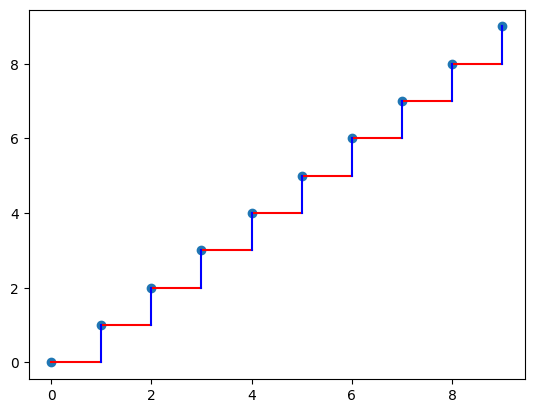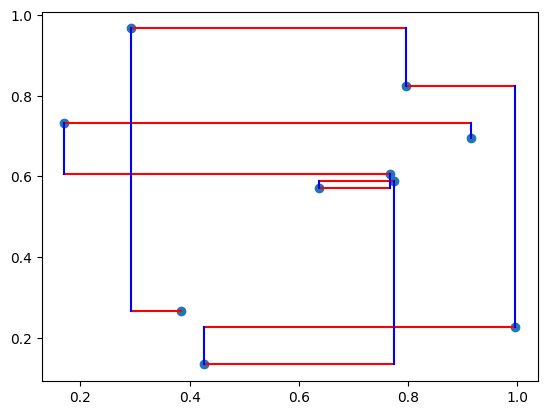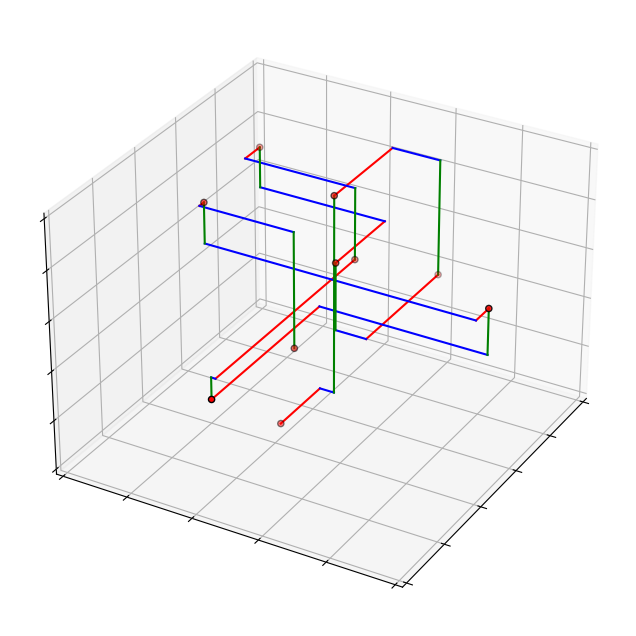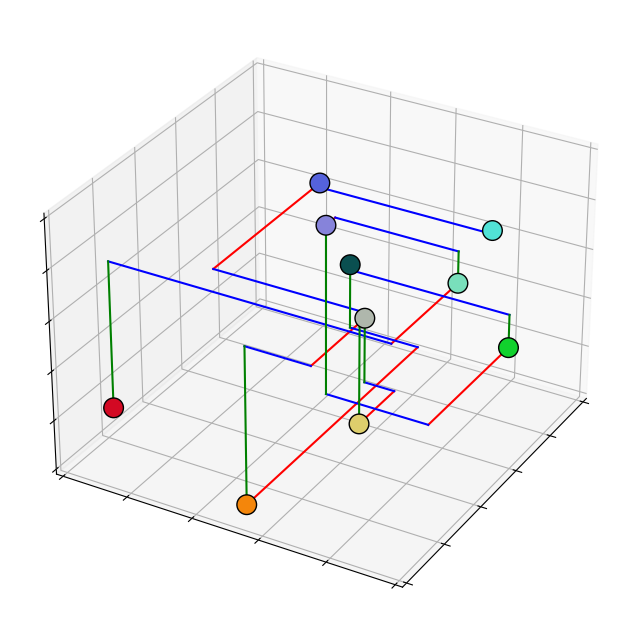散布図を作成した時に、L1距離をプロットする方法がなかったので自作した
import numpy as np
import matplotlib.pyplot as plt
x_hoge = np.arange(10)
y_hoge = np.arange(10)
plt.scatter(x_hoge, y_hoge)
#plt.plot([x_start,x_end],[y_start,y_end])
for i in range(x_hoge.shape[0] - 1):
plt.plot([x_hoge[i], x_hoge[i + 1]], [y_hoge[i], y_hoge[i]], c="red")
for i in range(y_hoge.shape[0] - 1):
plt.plot([x_hoge[i + 1], x_hoge[i + 1]], [y_hoge[i], y_hoge[i + 1]],c="blue")
出力画像
乱数にしたバージョン
x_hoge = np.random.rand(10)
y_hoge = np.random.rand(10)
plt.scatter(x_hoge, y_hoge)
#plt.plot([x_start,x_end],[y_start,y_end])
for i in range(x_hoge.shape[0] - 1):
plt.plot([x_hoge[i], x_hoge[i + 1]], [y_hoge[i], y_hoge[i]], c="red")
for i in range(y_hoge.shape[0] - 1):
plt.plot([x_hoge[i + 1], x_hoge[i + 1]], [y_hoge[i], y_hoge[i + 1]], c="blue")
出力画像
3Dplotバージョン
import numpy as np
import matplotlib.pyplot as plt
from mpl_toolkits.mplot3d import Axes3D
from matplotlib.animation import FuncAnimation
#データの作成
x_hoge = np.random.rand(10)
y_hoge = np.random.rand(10)
z_hoge = np.random.rand(10)
# figureを作成
fig = plt.figure(figsize = (8, 8))
ax = fig.add_subplot(111, projection='3d')
#figureの設定
ax.view_init(elev=30, azim=30)
ax.set_xlim([0, 1])
ax.set_ylim([0, 1])
ax.set_zlim([0, 1])
ax.tick_params(bottom=False, left=False, right=False, top=False)
ax.tick_params(labelbottom=False, labelleft=False, labelright=False, labeltop=False)
ax.scatter(x_hoge, y_hoge, z_hoge, color = "red",edgecolors='black')
#zx.plot([x_start, x_end], [y_start, y_end], [z_start, z_end])
for i in range(x_hoge.shape[0] - 1):
ax.plot([x_hoge[i], x_hoge[i + 1]], [y_hoge[i], y_hoge[i]], [z_hoge[i] , z_hoge[i]], c="red")
for i in range(y_hoge.shape[0] - 1):
ax.plot([x_hoge[i + 1], x_hoge[i + 1]], [y_hoge[i], y_hoge[i + 1]], [z_hoge[i] , z_hoge[i]], c="blue")
for i in range(y_hoge.shape[0] - 1):
ax.plot([x_hoge[i + 1], x_hoge[i + 1]], [y_hoge[i + 1], y_hoge[i + 1]], [z_hoge[i] , z_hoge[i + 1]], c="green")
plt.show()
出力画像
散布図を着色した場合
import numpy as np
import matplotlib.pyplot as plt
from mpl_toolkits.mplot3d import Axes3D
from matplotlib.animation import FuncAnimation
#データの作成
x_hoge = np.random.rand(10)
y_hoge = np.random.rand(10)
z_hoge = np.random.rand(10)
# figureを作成
fig = plt.figure(figsize = (8, 8))
ax = fig.add_subplot(111, projection='3d')
#figureの設定
ax.view_init(elev=30, azim=30)
ax.set_xlim([0, 1])
ax.set_ylim([0, 1])
ax.set_zlim([0, 1])
ax.tick_params(bottom=False, left=False, right=False, top=False)
ax.tick_params(labelbottom=False, labelleft=False, labelright=False, labeltop=False)
#カラーコードを作成
color_list = []
for i in range(x_hoge.shape[0]):
R_16 = '{:02x}'.format(int(x_hoge[i] * 255), 'x')
G_16 = '{:02x}'.format(int(y_hoge[i] * 255), 'x')
B_16 = '{:02x}'.format(int(z_hoge[i] * 255), 'x')
color_str ="#" + R_16 + G_16 + B_16
color_list.append(color_str)
#描画
ax.scatter(x_hoge, y_hoge, z_hoge, color = color_list, edgecolors="black", s=200 ,alpha=1)
#zx.plot([x_start, x_end], [y_start, y_end], [z_start, z_end])
for i in range(x_hoge.shape[0] - 1):
ax.plot([x_hoge[i], x_hoge[i + 1]], [y_hoge[i], y_hoge[i]], [z_hoge[i] , z_hoge[i]], c="red")
for i in range(y_hoge.shape[0] - 1):
ax.plot([x_hoge[i + 1], x_hoge[i + 1]], [y_hoge[i], y_hoge[i + 1]], [z_hoge[i] , z_hoge[i]], c="blue")
for i in range(y_hoge.shape[0] - 1):
ax.plot([x_hoge[i + 1], x_hoge[i + 1]], [y_hoge[i + 1], y_hoge[i + 1]], [z_hoge[i] , z_hoge[i + 1]], c="green")
plt.show()



